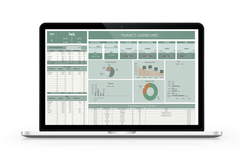Building an emergency fund might sound like a sensible adult thing you’ll “get around to”—right after you replace that wobbly chair and fix the dripping tap. But it’s one of the most powerful tools you can have for peace of mind. Whether it’s a surprise dental bill, a dead boiler, or job loss, having cash set aside means you can deal with it—without the added drama of debt.
Here’s how to build yours—no fluff, no overwhelm, just the essentials.
Try FREE Savings Splitter in Google Sheets
1. 🎯 Set a Target (That Doesn’t Scare You Off)
The classic advice says to save 3–6 months’ worth of essential expenses. Sounds great. Also sounds slightly terrifying. So if that feels like a mountain, just start with £500 or £1,000. That alone could cover a car repair or urgent trip to the vet.
Tip:
Calculate your must-pay costs: rent/mortgage, food, utilities. Multiply that by the number of months you want to cover—then halve it, just to get moving.
2. 🐢 Start Small. Stay Consistent.
Saving £20 or £50 a month might not feel like much, but over a year, it’s £240–£600 you didn’t have before. The secret sauce? Automate it. Set up a standing order into a dedicated savings pot and forget about it.
Bonus move: Use a bank with “savings pots” or round-up features to passively build your fund.
RELATED: Best Savings accounts, Crypto, DeFi and more
3. ✂️ Trim and Redirect
No need to go full monk. Just find one or two small luxuries to pause—takeaways, that extra streaming service—and funnel the savings into your emergency stash.
Example:
Cutting back £10 a week = £520 a year. That’s not just dinner—it’s financial breathing room.
4. 🏦 Keep It Out of Reach (But Not Locked Away)
Your emergency fund should be separate from your current account. Look for a high-interest savings account or a dedicated “emergency pot.” It needs to be easy to access in a pinch—but not so easy you “accidentally” spend it on Black Friday.
💬 Final Thought
You don’t need thousands in the bank overnight. You just need to start. Think of it as planting a money tree: slow at first, but one day it’ll save your bacon.
So start where you are, use what you have, and protect your future self—one small transfer at a time.





